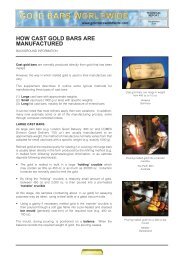Indian Gold Book:Indian Gold Book - Gold Bars Worldwide
Indian Gold Book:Indian Gold Book - Gold Bars Worldwide
Indian Gold Book:Indian Gold Book - Gold Bars Worldwide
Create successful ePaper yourself
Turn your PDF publications into a flip-book with our unique Google optimized e-Paper software.
GOLD JEWELLERY EXPORTS<br />
According to The Gem & Jewellery Export Promotion Council (GJEPC), around 800 enterprises<br />
fabricate plain or studded gold jewellery for export.<br />
Over the past 4 years, their duty-free import of gold has increased from 35 tonnes to 54 tonnes.<br />
<strong>Gold</strong> jewellery exports have surged over the past 10 years, from US$ 304 million in 1991-92 to US$ 1.2 billion in<br />
2001-02.<br />
Over the same period, value addition above the cost of gold used has grown from 24% to 51%, rising from US$ 73<br />
million to US$ 594 million.<br />
The jewellery export industry receives much government support through the GJEPC, which falls under the<br />
administrative control of the Ministry of Commerce and Industry.<br />
EXPORT FABRICATION LOCATIONS<br />
<strong>Gold</strong> jewellery for export is fabricated in 4 categories of location.<br />
Fabricators in SEEPZ (Mumbai) and in the Domestic Tariff Areas account for almost all gold jewellery exports.<br />
Special Economic Zones (SEZ)<br />
Isolated, demarcated manufacturing zones dedicated to exports. A new category, effective from April 2000.<br />
SEEPZ (Mumbai), converted to SEZ status in 2000, dominates the gold jewellery export industry. Its 72 large units<br />
(expected to increase to 120 by 2003) fabricate 44% of the value of India’s gold jewellery exports.<br />
Export Processing Zones (EPZ)<br />
Smaller, isolated, demarcated manufacturing zones dedicated to exports. MEPZ (Chennai) and NOIDA EPZ (near New Delhi)<br />
fall into this category, but their gold jewellery output is low.<br />
Export Orientated Units (EOU)<br />
These units can be located anywhere. A Customs officer is also obliged to be in attendance 24 hours daily to monitor all<br />
materials brought into and out of each unit.<br />
Domestic Tariff Areas (DTA)<br />
Defined as any location falling outside a demarcated zone. Fabricators in DTA’s account for 52% of the value of gold<br />
jewellery exports.<br />
EXPORT MARKETS<br />
3 countries account for 85% of the value of India’s gold jewellery exports: USA (55%), United Arab Emirates<br />
(20%) and the United Kingdom (10%).<br />
Export growth over the past 10 years has relied largely on the USA market, sales having increased from less than US$ 100<br />
million in 1991-92 to US$ 647 million in 2001-02.<br />
PRODUCTS<br />
Almost all gold jewellery fabricated in the export zones is studded, mainly with diamonds.<br />
Although SEEPZ (Mumbai) accounts for 44% of the value of gold jewellery exports, its 72 units are reported to produce<br />
studded gold jewellery only.<br />
However, fabricators in the DTA’s, accounting for 52% of the value of gold jewellery exports, are reported to produce a<br />
substantial amount of plain gold jewellery.<br />
Most export products are fabricated to meet the precise requirements of overseas customers. Although many customers<br />
provide detailed drawings, most fabricators have in-house designers as well.<br />
136<br />
AN INTRODUCTION TO THE INDIAN GOLD MARKET

















